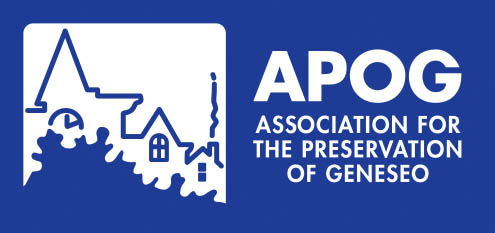Hartford House
2006
Courtesy of Joan Ballard
The history of Hartford House and the Wadsworth family associated with it has been thoroughly documented by Alden Hatch's The Wadsworth of the Genesee in 1959 and by Alice Wadsworth Strong in a delightful personal account written in 1985 to mark the 150th anniversary of the construction of the mansion. Since no series of articles on buildings in Geneseo would be complete without its inclusion, the following is an attempt to present a brief chronological history of Hartford House and its occupants.
James Samuel Wadsworth (later General Wadsworth), born in 1807, was the eldest son of the pioneer James and his wife Naomi Wolcott. In 1834, he married Mary Craig Wharton of Philadelphia. While on their wedding trip in England, they met Lord Hertford and were so charmed by his "villa" in Regents Park that they persuaded him to give them a copy of its plans. Upon returning to Geneseo, they chose a spot at the north end of the village and construction of Hartford House was begun immediately. It was a large handsome two-story house with hyphenated wings on either side and was covered with stucco. The unadorned east facade had a portico covering the main entrance. The west facade was enhanced by two-story double bays and a porch extending the width of the central block from which there was a breath-taking view of the valley.
James and Mary were the parents of six children born between 1835 and 1848. In 1851 the entire family made a grand tour of Europe. During their absence a third story was added to the center block of the mansion to afford additional room for the large family. When the Civil War broke out, James enlisted and attained the rank of Major General. After highly commended service at Gettysburg, he was killed during the Battle of the Wilderness in 1864. His widow continued to reside at Hartford House and upon her death in 1874, it was left to their son, James Wolcott Wadsworth.
c. 1875
Courtesy of Jon and Liz Porter
In 1876 James Wolcott Wadsworth married Maria Louise Travers of New York City. They added a porte-cochere to the main entrance and in 1890 replaced an old stone gateway at the entrance to the estate and added a fence of iron paling. In 1891 they extended this for about a half mile from the Court House along the Avon Road. After a long residency James (also known as “the Boss”) died in 1926. Louise died in 1931 and Hartford House passed to their only son, James Wolcott Wadsworth, Jr.
c. 1909 West face of Hartford House
Courtesy of Livingston County Historian
James W. Wadsworth, Jr., had been pursuing a brilliant and distinguished political career. He served for six years as New York State Assemblyman, five years as Speaker, and from 1914 to 1926 as United States Senator. In later years, he was elected to Congress. At the time of his mother's death, he and his wife, the former Alice Hay, whom he had married in 1902, were living at Hampton, their estate in Groveland. They made plans to move to Hartford House only after extensive renovations could be made, but a destructive fire destroyed Hampton in 1932 and they were forced to occupy Hartford during the renovations. The front hall was enlarged. Much of the heavy Victorian interior decoration was removed in an attempt to lighten the atmosphere which they found oppressive, and new wall paper and paint were applied. They also extended the south room fifteen feet to the west, creating a library. They paneled it in white mahogany taken from the Washington residence of Mrs. Wadsworth's father, former Secretary of State, John Hay.
1977
Courtesy of APOG
Senator and Mrs. Wadsworth were the parents of three children. James Jerimiah married the former Harty Tilton and served as New York State Assemblyman, and later, as Ambassador to the United Nations. Upon graduation from Yale in 1927 he did operate a dairy farm on Reservoir Road on what is now the McClelland property. Unfortunately he had to quit farming during the depression and move back into the Big House with his wife and child, Alice. After being elected to the State Assembly in 1930, he spent part of the year in Albany and the rest in Geneseo at Hartford House. After retiring from government service in 1970 he purchased the former "Mutt" Townsend house on Avon Road, where he lived until his death in 1983. Evelyn married Stuart Symington and moved to Missouri where he became a United States Senator. Reverdy married the former Eleanor Roosevelt and lived at Cornerways in the village. He managed the family farm and rental properties and was active in local affairs. Senator Wadsworth, later Congressman Wadsworth, died in 1952. He left life use of Hartford House to his widow and upon her death in 1960 ownership passed to Reverdy.
Reverdy and Eleanor Wadsworth modernized the kitchen and replaced any remaining heavy dark furniture with beautiful antiques that had been in the Roosevelt family. Reverdy continued in the day-to-day management of the Wadsworth lands until his sudden death in 1970. A few years later, his widow returned to Cornerways. Their only son Harry, then living in Denver, had at that time no plans of returning to Geneseo.
A collective sign of relief was felt in the valley when it was learned in 1975 that Alice Wadsworth Strong, daughter of Ambassador J. J. Wadsworth, and her husband Trowbridge had purchased Hartford House, ensuring that it would remain with the Wadsworth family. James Jeremiah Wadsworth gave them the money to construct an in-ground pool as a housewarming present. Mr. and Mrs. Strong made further alterations to the kitchen and improvements to other areas of the house, outbuildings and stables. The Strong’s have hosted numerous community functions, hunt breakfasts and hunt balls and have been generous in opening it for special occasions.
Their oldest son, Corrin Strong, who had moved to the Valley at age 24, supervised the construction of the in-ground pool while attending SUNY Geneseo as a transfer student.
After both his parents had passed away by 2001, Corrin became the new owner of the Big House, although the property was split so that his sister Susan Kelley received the barn complex, a cobblestone house north of the main house and a large part of the acreage extending out to the GCS.
Susan operates a horse riding academy, Big House Stables, and in recent years constructed a year-round indoor riding facility. She also made a substantial improvement and expansion of the cobblestone house which is her residence.
Upon taking ownership, Corrin, who has 4 children, immediately began construction of a 2,100 square foot addition on the north end of the Hartford House. The plans were reviewed by an APOG consulting architect and the addition was clad in stucco to match the main house.
Corrin moved in in February 2002 and lives there to this day. This allows him to live much more economically without the prohibitive cost of heating the 13,000 square-foot original house. The only parts of the main house that are heated year-round are the main kitchen and 3 apartments that he rents out on the north end of the house.
Over the years Corrin has made additional improvements to the property, including the construction of a Har-Tru tennis court in 2008. He also constructed a croquet court and founded the Genesee Volley Tennis & Croquet Club, which has provided much joy to local sportsmen over the years.
Around 2011, Corrin ventured into the Bed and Breakfast business by converting the second story "apartment" on the south end of the building into a B & B unit. He named it the Garden Suite as it overlooked the walled garden that Alice Hay had installed on the south end of the house in the 1930s.
In 2019, he made extensive improvements to the infrastructure of the 2nd floor of the main house and expanded the B & B operation with 3 additional units. The new operation including the Garden Suite was re-christened Hartford House Bed and Breakfast.
All of the B & B units are only opened seasonally from May to October, except for the Garden Suite which has been operating year-round after baseboard electric heat was added in 2020.
Over the years Corrin has done major repair work to the masonry around the estate including the large formal garden north of the house, which was the site of the 1948 wedding of his parents. That outside venue is now offered to the public for weddings and events.
In support of that, Corrin added two handicap-accessible bathrooms in 1/2 of the former garage adjacent to the tennis court. The other half of the building now serves as his farm shop. In his spare time, he operates Free Soil Farm, where he grows about 3 acres of vegetables that are sold at local Farmers Markets.




